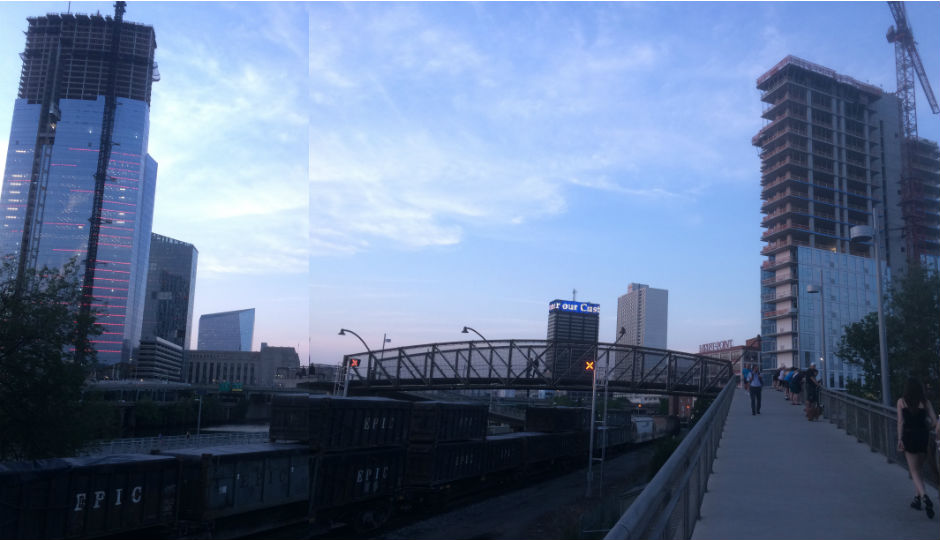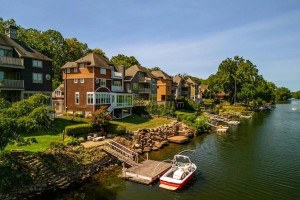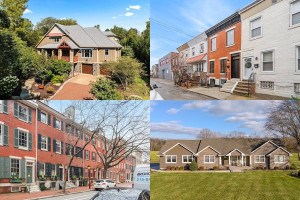Study: Walkable Development Can Make Philly Smarter – And Richer

Projects like the FMC Tower at Cira South (left) and One Riverside (right) are transforming the Schuylkill riverfront into the core of the region’s knowledge economy. An updated study of walkable urban development says more walkable regional centers in Philly’s suburbs would further strenghten the economy. | Composite photo by Sandy Smith
Those construction cranes hovering over Center City and University City are making Philadelphia’s future a little more accessible and a lot smarter.
They’re adding office space, retail space and residents to the region’s principal “WalkUPs” — “walkable urban places,” or districts of regional significance that contain large amounts of office and retail space that can be easily traversed on foot, with residents interspersed or nearby.
LOCUS, the developers’ advocacy group affiliated with Smart Growth America, just updated its “Foot Traffic Ahead” study of walkable urban development in the nation’s 30 largest metropolitan areas. The study, conducted by Christopher B. Leinberger and Michael Rodriguez at the Center for Real Estate and Urban Analysis at the George Washington University School of Business, ranks the metros based on the percentage of total office, retail and multifamily residential space in walkable urban places.
In the first study in 2014, which did not include data on multifamily residential, Philadelphia ranked 13th out of the 30 metros, with 19 percent of its office and retail space in “WalkUPs.” The edition being released today ranks the region 10th, with 17 percent of its office and retail space and multifamily housing units in WalkUPs.
Topping the list this time around is New York City, where WalkUPs contain 38 percent of the region’s total office, retail and multifamily residential space. But, the authors note, New York makes a poor model for regional development, for 94 percent of this total lies within New York City itself, and 80 percent is found on Manhattan Island, which accounts for a mere 0.3 percent of the region’s land mass and eight percent of its 21 million inhabitants. Number-two ranked Washington, DC, has a more balanced pattern of development: 47 percent of its walkable urban places are in the city’s suburbs.
In terms of forward momentum for future walkable development, the region ranks 13th this time around, also a rise of three places from its 16th-place ranking in the first study. This is one area where Philadelphia might want to emulate Detroit, a city Philadelphians often point to anxiously as a portent for its own future: only New York and Boston scored higher than Detroit on this metric, which measured the share of regional development captured by WalkUPs, their share of total regional office and multifamily residential space absorption, the rent premium for WalkUPs over the “driveable sub-urban” development that has characterized most American urban development in the previous 60 years, and the change in that rent premium over the previous five years.
Philadelphia’s suburbs remain ripe for such development, based on data in the report: 16 percent of the region’s suburban office, retail and multifamily residential space is contained in walkable urban districts. Suburban jurisdictions that encouraged such development would see the benefit in their municipal coffers thanks to the 63 percent rent premium WalkUPs in this region enjoy, a rise of 15 percent since 2010.
But, Leinberger said in a news conference, continued resistance to such development in the suburbs stymies this potential. Leinberger, who is also president of LOCUS, has some familiarity with regional development issues through a Narberth-based development firm. “The NIMBY opposition in [metro] Philadelphia is legendary,” he said. “Developers have ranked Philadelphia as the worst place to do business because of NIMBY opposition. The concern is that density will destroy the character of their communities when the opposite is the case.
“Our research shows that WalkUPs take up three to six percent of the total land in a metropolitan area. Those large homes on the Main Line will benefit from their proximity to WalkUPs.”
Exhibit A in support of his argument is Ardmore, where a group of determined opponents has held up a mixed-use residential/retail project proposed by developer Carl Dranoff that the local business improvement district sees as the linchpin for its plans to shore up and strengthen the Main Line’s principal Main Street. Meanwhile, in King of Prussia, leaders of its business improvement district are taking steps to add walkable development to an auto-oriented landscape, replicating a process that has made Tysons Corner outside Washington one of the WalkUPs that give that region its high ranking.
Leinberger noted that this region already has a key asset around which WalkUPs can form, namely, SEPTA’s Regional Rail network, which the report labeled as “poorly maintained.” “You’ve got this great rail network in place and you’re not taking advantage of it,” he said. “This could be 30 or 40 percent of your economic growth if you allow it to happen, but you may or may not.”
Leinberger pointed to another Montgomery County, the one in Maryland, as a potential model for this region to follow. There, he said, residents and developers around Metro stations came to the realization that “eight-lane traffic sewers wouldn’t make sense” as avenues for redevelopment and opted instead to channel development to the areas around the stations. “The NIMBYs became YIMBYs,” he said. Developers helped ease the strain on municipal budgets by picking up one-third of the infrastructure costs related to this development.
Promoting such development would also strengthen this region’s knowledge economy, which is right now most heavily concentrated in the “innovation district” of University City. “The key takeaway of this report is that high WalkUPs are what the knowledge economy is demanding, which is why we’re seeing so many educated workers in the WalkUPs,” Leinberger said. “We’re seeing a correlation between the education of the workforce and WalkUPs, but we also see a causation between education of the workforce and per capita GDP.”

